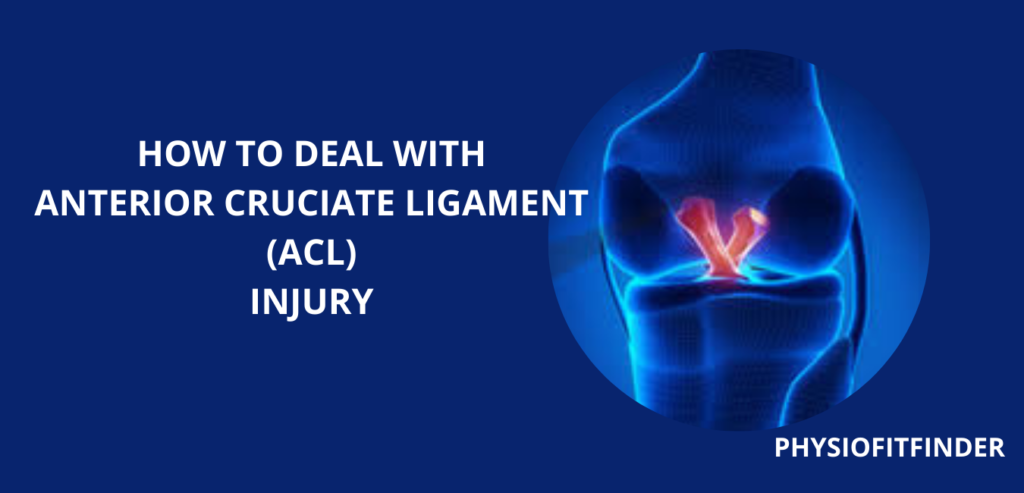The anterior cruciate ligament (ACL) is one of a pair of cruciate ligaments, the other one is Posterior cruciate ligament (PCL). Also called as cruciform ligaments, it courses from the femur to the tibia. Without a doubt ACL is a key structure in the knee joint as it assists in controlling excessive motion.
ORIGIN OF ANTERIOR CRUCIATE LIGAMENT
ACL arises from the posteromedial corner of medial aspect of lateral femoral condyle in the intercondylar notch and is attached distally to the tibia on the lateral and anterior aspect of the medial intercondylar tibial spine.
FUNCTION
The anterior cruciate ligament (ACL) functions as the primary restraint against anterior translation of the tibia on the femur. In addition, it provides rotary stability of the knee during medial and lateral rotation. Approximately 85% of total restraining force of anterior translation is supported by ACL.
INJURIES
An ACL tear is one of the most common knee injuries. Most ACL tears are a result of a non-contact mechanism such as a sudden change in a direction causing inward rotation of knee.
EVALUATION
Evaluation of the ACL should be performed immediately after an injury if possible, but is often limited by swelling and pain. A complete knee examination is required.
DIAGNOSIS
Magnetic resonance imaging (MRI) is the primary study used to diagnose ACL injury.
SPECIAL TESTS FOR ANTERIOR CRUCIATE LIGAMENT INJURY
- LACHMAN TEST
- ANTERIOR DRAWER TEST
- PIVOT SHIFT TEST
The Lachman test is the most accurate test for detecting an ACL tear.
TREATMENT FOR ANTERIOR CRUCIATE LIGAMENT INJURY
Treatment consists of conservative management or surgical intervention, with the latter being the better option for patients who want to return to a high level of activity.
CONSERVATIVE MANAGEMENT
The major goals of rehabilitation for knee with ACL injury:
- Gain maximum functional stability
- Maximize muscle strength
- Decrease the risk for re-injury
PHASES IN NON-OPERATIVE TREATMENT OF ANTERIOR CRUCIATE LIGAMENT
ACUTE PHASE
During this phase, the rehab is focused on the acute symptoms that occur right after the injury and are causing an impairment. The use of therapeutic exercises and appropriate therapeutic modalities is crucial during this phase to assist in repairing the impairments from the injury.
MAXIMUM PROTECTION PHASE : (WEEKS 1-3)
- Examine before effusion sets in, if possible.
- Use cold & compression with rest and elevation.
- Teach safe transfer activities to avoid pivoting on the involved extremity.
- Teach protected weight bearing with use of crutches.
- Subsequently, initiate quadriceps setting exercises.
PRICE (protective bracing)
- Ambulation training with crutches, weight bearing as tolerated
- Passive range of motion (PROM)/Active assisted range of motion (A-AROM)
- Patellar mobilization (grade I & II)
- Muscle setting quadriceps, hamstrings and adductors (may augment with E-stim)
- Straight leg raises (SLRs)
- Aerobic conditioning
MODERATE PROTECTION PHASE : (WEEKS 3-6)
- As swelling decreases, examine the patient for impairment and functional losses.
- Initiate joint movement and exercises to improve muscle performance, functional status along with cardiopulmonary conditioning.
- Continue multiple-angle isometrics
- Initiate Progressive resistance exercises (PRE)
- Closed-chain strengthening
- Lower Extremity flexibility exercises
- Endurance training
- Perturbation/balance training
- Stabilization exercises
- Initiate a walk or jog program at the end of this phase
NEUROMUSCULAR TRAINING PHASE
The Neuromuscular Training Phase is used to focus on the patient regaining full strength in both the lower extremity and the core muscles. This phase begins when the patient regains full range of motion, no effusion, and adequate lower extremity strength.
MINIMUM PROTECTION PHASE : (WEEKS 5-8)
- Continue Lower Extremity flexibility exercises
- Progressive resistance exercises (PRE) strengthening to be advanced
- Advance close chain exercises
- Higher perturbation training
- Advance endurance training
- Progress running program
RETURN TO SPORT PHASE
The final phase is the Return to Sport Phase, and during this phase the patient will focus on sport-specific activities and agility.
RETURN TO ACTIVITY PHASE: (WEEKS 8-12)
- Continue flexibility and strengthening; advance as appropriate
- Advance agility drills
- Progress running drills
- Advance perturbation drills
- Implement drills specific to sport or occupation
- Determine need for protective bracing prior to return to sport or work
PREVENTION FOR ANTERIOR CRUCIATE LIGAMENT INJURY
Primary prevention of ACL injury includes specific proprioceptive and neuromuscular training exercises to improve knee stability. In particular a specialist in sports medicine, physiotherapist or athletic trainer can provide proper instruction and feedback that can help to reduce risk of ACL injury.

Really helped a lot